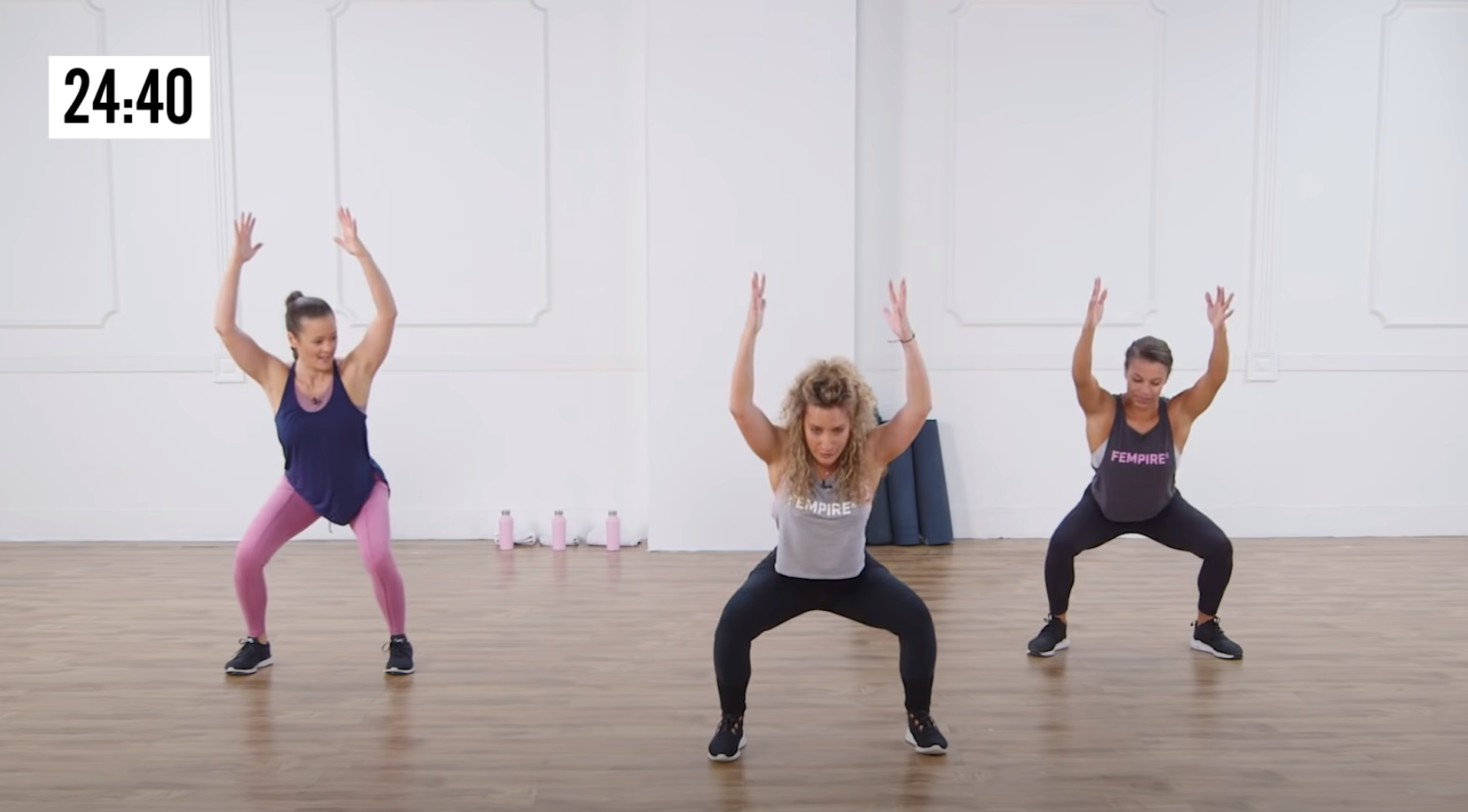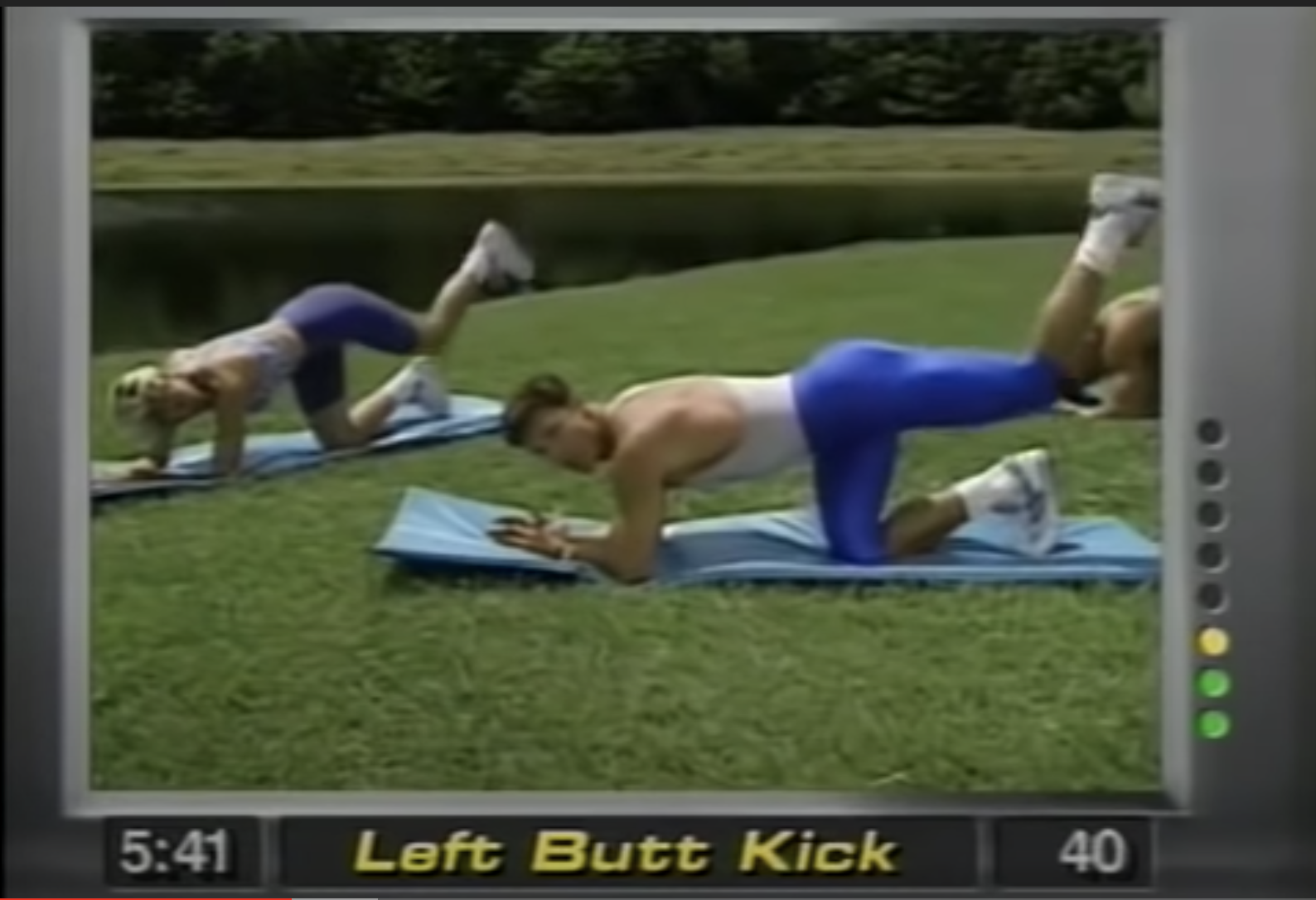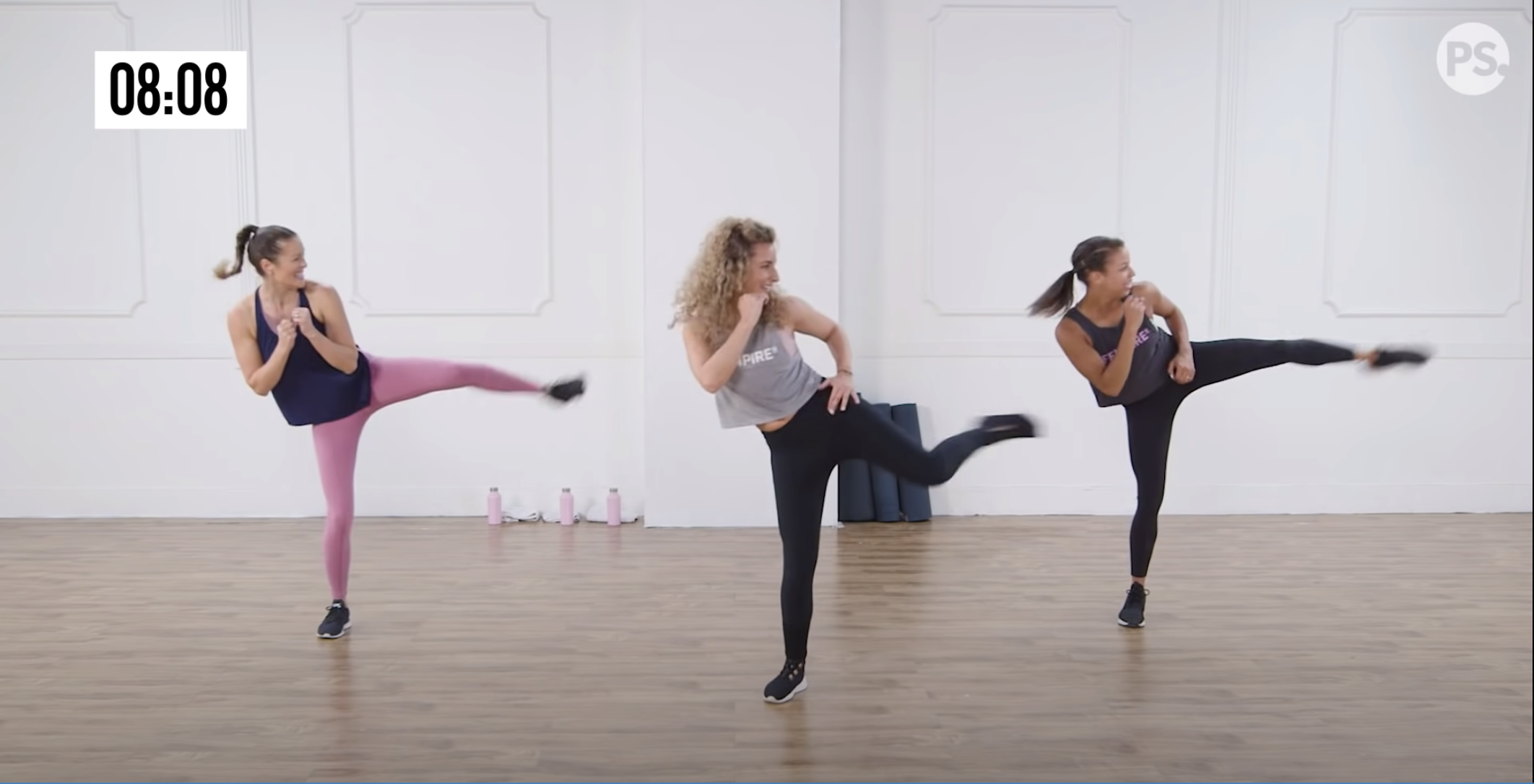the cozy emptiness of YouTube fitness
On YouTube, every muscle is a glute - or could be.

You would be shocked by how many books about grief there are. Do a quick google search and you'll find literature about how to reckon with the loss of a parent, a child, a spouse, a pet, a job, a sibling, a cousin, a different cousin you never liked but feel familial pressure to mourn, and a tree upon which you attached an inappropriate volume of emotion before it was cut down by a municipal government playing fast and loose with eminent domain. I will not Google this but I am certain, more certain than I have ever been, that someone has written about how to holistically mourn the passing of Supreme Court Justice Ruth Bader Ginsburg (no books about Scalia). As someone who endured significant loss at a young age, these tomes were deposited into my hands with the same frantic, violent energy of someone paying for lunch with coins - it's technically legal, yes, but not always appreciated.
Twelve-year-old Julian read many grief books. I recall very little of what they prescribed, except that every single one urged me to cope by writing and then by writing some more - in essence, they fucked me up so comprehensively that it is you, right now, enduring the consequences. But I do remember what they did not teach. No book provided guidance on how to make your parents smile again, nor did any advise how to resell the fake Rolex that your deeply uncomfortable Hebrew school teacher guiltily bestowed upon you at the post-funeral lunch. The bereavement books forget - or don't know how - to give instructions on what to respond to the classmate who, after learning about what happened, stoically extends a lonely piece of gum as consolation (I said "thanks"). But that's not the most glaucomic blind spot that this cottage industry of misery possesses. To find that, all you have to do is open any book of your choosing, scroll past the chapters about how moving on is what RBG would have wanted for you (not for everyone, but for you), and arrive at the index. Look up the word 'tortellini.' I guarantee that your finger, searching up and down the margins, will not be compelled to stop.
I internalized my brother's loss in countless ways too complex for the psychiatric community to solve but I externalized it, if you will, very simply: I ate tortellini for every single meal for two weeks after his death. Blame a juvenile lack of discipline, blame the family friend who arrived at my home each morning with a fresh box and a nauseatingly compassionate expression smeared across her face, blame Berlusconi. Whomever you deem deserving of fault, the end result was a preteen with graceful, sloping birthing hips, a sophisticated appreciation of the nuances of Barilla's Tortellini Collezione, and an adolescent psyche governed by the clenched fist of pudginess.
Anyone who grew up chunky will tell you that the experience is formative. While other kids were out enjoying their first adrenaline-laced tastes of sucking face or lungs filled with hazy fumes, the portly among us were at home wearing our mothers' maternity pants and figuring out how to heat up a midnight frozen pizza without waking their parents (it's actually very simple - just eat it frozen). There is no easy way to travel through puberty, no elegant path over the brambles of abrupt change, but to weather all those adjustments while also needing to buy an iron-reinforced bedframe is a specific form of hardship. The insecurity, the diminished sense of self-worth, the hollow feeling of watching your mother try to bury her sobs as you singlehandedly finish an entire family-sized platter of chicken parm...these are difficult emotions for anyone to wrestle with at any age, but doubly so when one is so young and the world has already revealed itself as capable of such cataclysmic cruelty.
I was probably thirteen when I first decided that I wanted to change both who I was and the groaning sounds that chairs made when I lowered myself into them. Dieting didn't take and conventional exercise (also known as my mother dragging me on 6 AM jogs along the Hudson River; victims of the Bataan Death March complained less) was anathema to my very being. All seemed hopeless. But then, at my darkest hour, I discovered a beautiful solution, one that diminished the pain of my least favorite thing (movement) by combining it with my favorite thing (not leaving my room): the vast, fluorescent world of YouTube workouts.
If you also like to exercise at home, maybe on your Peloton, or perhaps via some frou-frou subscription service that delivers you daily, customized workouts, you might at this point be feeling a certain simmering sense of solidarity. I want to be very clear here - we are not the same. Those courses sculpt and strengthen your body; they target specific muscle groups and provide metrics that make it easy to track your progress. Working out to YouTube, on the other hand, assumes the general shape of what the American healthcare system would look like if the Republicans got their way - you're on your own, your body is perpetually in danger, and as much as you might hate it, you're gonna like it.
I have broken down the oeuvre of YouTube fitness into two distinct categories. First, we have what I call "no one who participated in this video is still ambulatory today." This genre is defined by workouts first recorded during the early years of the George H.W. Bush Administration - you can almost taste the lingering aftershocks of Iran-Contra through the scratchy VHS upload - and the accompanying music is uniformly, relentlessly pornographic. Colors are bright, the instructors are clad in tights clingier than saran wrap, and the man leading the exercises (always a man) motivates you with the nauseating optimism of someone years away from first encountering the TSA. There is perhaps no better example than '8 minute buns' - just one of many members of the larger '8 minute' genus; others include '8 minute abs,' '8 minute legs,' and too much more - which instantly betrays the viewer's trust by clocking in at eight minutes and twenty seconds. When your buns are burning, twenty seconds is a decade.

'8 minute buns' and its ilk are relics of a different time, a feverish memory of an empire pre-decline, where pesto was an exotic foreign import and plane hijackings were just a normal thing that happened, as unremarkable as French presidents possessing not-so-secret mistresses. The fitness techniques and verbiage employed reflect the moment. In 'Buns', every muscle is a glute, or could be. The instructor - he has a name that I refuse to learn - cajoles a fuller range of motion by encouraging you to picture how good those jeans will look on the new body you will soon proudly own, presumably seven minutes from now. He does not need to explicitly describe the jeans for everyone listening to imagine their blindingly bright acid wash, such is the power of his subtext.
Abruptly, the workout ends and the man is now sitting up, staring directly at you and demanding that you return tomorrow, where after eight minutes (and twenty seconds) of the exact same contortions you did nineteen hours ago, he will again insist that you return tomorrow. For a not-insignificant portion of my life, maybe five years, these videos were the sum total of my aerobic exercise. It is as much of a shock to me as it is to you that despite my remarkable dedication, my buns are not quite made of steel; on their best day, they are maybe an aluminum alloy.
The second type of workout video is colloquially referred to as "all the instructors hate each other in HD." There is a definitive masterpiece within this contemporary variety - PopSugar Fitness' (the ExxonMobil of YouTube exercise channels) '30-Minute No-Equipment Cardio Kickboxing Workout.' This is the type of video that no one goes looking for; you find it only by accident via the one sincere comment deep in a Twitter thread mocking Jen Psaki for her recommendation that Democrats console themselves over the party's galling failure to advance voting rights legislation by "feel[ing] those emotions, go[ing] to a kickboxing class, [and] hav[ing] a margarita."
Let me get something out of the way first - this is a great workout. The core is engaged, as are the legs and arms and those pesky buns. There is a brief incorporation of the spiritual but only in a nonthreatening, vaguely midwestern sort of way. One emerges thirty minutes later coated in a shiny sheen, feeling vaguely toned. But that's not why I come back, week after week. I return for the resentment that the two visiting instructors feel towards the third woman, Anna (she of the pink leggings), a deep discontent that they make no effort whatsoever to conceal.

There is always a faint echo of the hostage video beneath these online workouts - the instructors stare directly, endlessly into the camera, plaster plastic smiles across their wrinkle-free faces, and read lines from a script that they clearly do not believe. That underlying animosity is heightened at numerous points within this video, like when Anna repeatedly responds with a forceful "no" when Eliza (the leader) asks if everyone is doing ok. The tenor only grows as Anna employs problematic, Stockholm Syndromeesque terminology like "I asked for it" after complaining about how much cardio this workout entails (it's not that much cardio), and at one point during the cooldown, says "I could stay here all day," to which Eliza responds icily, "please do." I find the disgust they hold for one another phenomenally motivating. Nothing makes me more willing to sweat.
To hone your body in the arena of YouTube is to both revel in incredible frugality and to work out not for health or aesthetic purposes, but for a love of the game. I am well aware that I could achieve a more improved physical state by going to the gym or, say, walking up a single flight of stairs, and yet I return nonetheless. My rationale isn't complicated: after enough iterations, these videos begin to assume a pattern of familiarity, feel like home. You know exactly when Eliza is going to tell you to smile, the precise thrust where 8 minute guy invents some bizarre, non-existent word to describe lifting your pelvic floor towards God, and just as you're beginning to fade, you remember that you are only seconds away from Anna's lowest, most humiliating point (it can be found at the 14:04 mark; I have considered getting the timestamp tattooed), where she stumbles unintelligibly over her words. As she garbles nonsensically, a smug Eliza produces the biggest, shit-eating grin that YouTube will allow. That fleeting moment is bliss, you forget that you are in terrible, perpetual movement, and the feeling that washes over your not-quite chiseled body is almost as delicious as a bowl of grief-stricken tortellini.
These YouTube workouts, in all their impersonal glory, are more than just bizarre productions of the absurd. For tween me, desperate to avoid any interaction that might invoke a discussion of grief or - worst of all - force an answer to the dreaded question "do you have any siblings?," these videos offered a beautifully vacuous escape. The grief books do a truly abysmal job of warning you that immediately after the tragedy occurs, your entire identity - like it or not - will fade into the murk of trauma. It does not take long to realize that you are always being watched and you soon become practiced at detecting the pity governing the quickness with which people are willing to forgive and indulge. You receive special treatment that feels sinister; the months of poorly concealed scrutiny and weakly forced smiles take their toll. Inevitably, you recognize that in the eyes of many, you have been minimized: you are no longer an individual but merely Someone Who Lost Someone, an archetype of grief whose behavior must constantly be monitored for evidence of simmering anger or wallowing depression. But the YouTube Videos could care less about who you are or what happened to you. They just want you to add your own intensity to the exercise, work the glutes, and come back tomorrow.
It is a bit indulgent to describe these workouts as a sanctuary - I have never spent a single moment of them not miserable - but they do deliver a form of judgment-free companionship. Their inherent inability to change lends them a sterile stability; the fact that they are pre-recorded means that they cannot ask prying questions or offer contrived compassion. There is a reason that many of these workouts have millions of views ('8 minute abs' has over thirty-two million, which can only be interpreted as a foreboding omen of something dark and imminent) - one need only read the comments to see that for the recently pregnant mothers of the world, the socially anxious and the asthmatic, this is a rare place where it is safe to be vulnerable.
YouTube workout videos surged in popularity during COVID as the world retreated from gyms and, well, the world. I imagine that those figures represent the high-water mark of YouTube fitness - with the pandemic fading into a gentle, familiar hum, many have already returned to their pre-March 2020 routines. But for others - myself very much included - there is warm reassurance in knowing that these videos will always be there, pillars of constancy in a world equally unpredictable and vicious, a glassy-eyed instructor eternally available to cheerily point at a bicep while telling you to engage your glutes.
